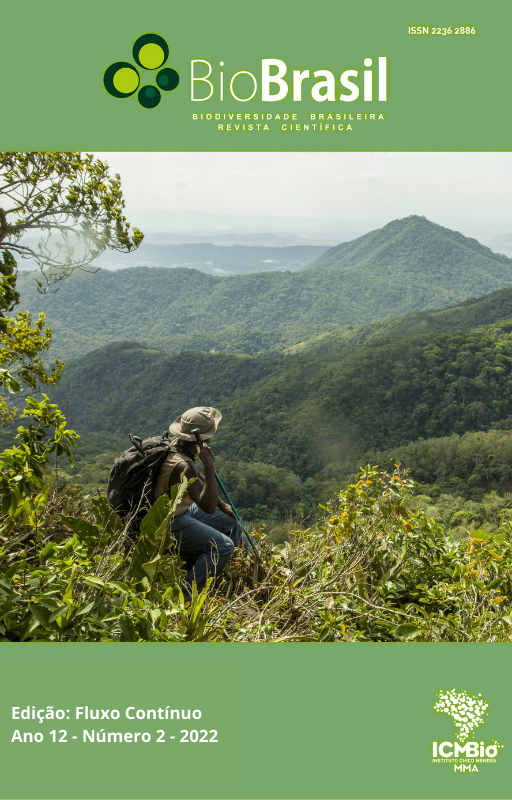Variabilidade temporal da fauna edáfica e seus grupos funcionais em sistema agroflorestal
DOI:
https://doi.org/10.37002/biodiversidadebrasileira.v12i2.1918Palavras-chave:
Diversidade da biota edáfica, Floresta ombrófila mista, Mudanças climáticas, Macroartrópodes edáficosResumo
A abundância de indivíduos da fauna edáfica varia substancialmente em função das variações sazonais em ecossistemas subtropicais. O objetivo deste estudo foi avaliar a abundância e diversidade de organismos edáficos em função da sazonalidade em um sistema agroflorestal localizado no Sul do Brasil. Usando métodos de extração de indivíduos e identificação taxonômica em níveis de Família e grupos-funcionais em diferentes épocas (e.g., estações do ano), foram observadas, durante a primavera, as maiores abundâncias de indivíduos (e.g., Blattidae, Carabidae, Larvas de Culicidae, Forficulidae, Halictophagidae, Larvas de Muscoidea e Nitidulidae) e de todos os grupos-funcionais observados neste estudo (e.g., herbívoros, engenheiros de ecossistema, transformadores de serapilheira e predadores). Além disso, foi observado que características edafoclimáticas como precipitação, temperatura mínima, carbono orgânico total e nitrogênio são os principais fatores que contribuem com a variabilidade sazonal da fauna edáfica. Os resultados deste estudo demonstram a importância de considerar as famílias Acaridae, Araneidae, Blattidae, Carabidae, Formicidae, Halictophagidae, Isotomidae, Larvas de Muscoidea, Nitidulidae, Paronellidae, Staphylinidae, Thripidae como bioindicadoras de alterações ambientais.Â
Referências
Abbas MJ & Parwez H. Seasonal diversity of soil microarthropods in two different vegetable plots of Aligarh-India. Tropical Ecology, 61(3): 311-316, 2020. https://doi.org/10.1007/s42965-020-00091-9.
Anderson JN & Ingram JSI. 1993. Tropical soil biology and fertility: A handbook of methods. CAB International, Wallingford. 221p.
Ardestani MM, Å ustr V, Hnilicka F & Frouz J. Food consumption of the cockroach species Blaptica dubia Serville (Blattodea: Blaberidae) using three leaf litter types in a microcosm design. Soil Ecology, 150(1): e103460, 2019. https://doi.org/10.1016/j. apsoil.2019.103460.
Bach EM, Ramirez KS, Fraser TD & Wall DH. Soil biodiversity integrates solutions for a sustainable future. Sustainability, 12(7): 2662-2684, 2020. https://doi. org/10.3390/su12072662.
Black CA. 1965. Methods of soil analysis. 1 ed. American Society of Agronomy. 1572p. https://doi. org/10.2134/agronmonogr9.2.index.
Camara R, dos Santos GL, Pereira MG, Silva CF, da Silva VFV & Silva RM. Effects of natural Atlantic Forest regeneration on soil fauna, Brazil. Floresta e Ambiente, 25(1): 2-10, 2018. http://dx.doi.org/10.1590/2179- 8087.001716.
Cui Y et al. Natural grassland as the optimal pattern of vegetation restoration in arid and semi-arid regions: evidence from nutrient limitation of soil microbes. Science of the Total Environment, 648(1): 388-397, 2019. https://doi.org/10.1016/j.scitotenv.2018.08.173.
da Silva DM et al. Effects of pig slurry application on the diversity and activity of soil biota in pasture areas. Ciência Rural, 46(10): 1756-1763, 2016. http://dx.doi. org/10.1590/0103-8478cr20141869.
Evans KS et al. Soil fauna accelerate dung pat decomposition and nutrient cycling into grassland soil. Rangeland Ecology & Management, 72(4): 667-677, 2019. https://doi.org/10.1016/j.rama.2019.01.008.
Hoffmann AA et al. Impacts of recent climate change on terrestrial flora and fauna: Some emerging Australian examples. Austral Ecology, 44(1): 3-27, 2019. https:// doi.org/10.1111/aec.12674.
Kitamura AE, Tavares RLM, Alves MC, de Souza ZM & Siqueira DS. Soil macrofauna as bioindicator of the recovery of degraded Cerrado soil. Ciência Rural, 50(8): 2-8, 2020. https://doi.org/10.1590/0103- 8478cr20190606.
Kooch Y & Noghre N. The effect of shrubland and grassland vegetation types on soil fauna and flora activities in a mountainous semi-arid landscape of Iran. Science of The Total Environment, 703, 2020. https:// doi.org/10.1016/j.scitotenv.2019.135497.
Laurindo LK et al. Arbuscular mycorrhizal fungal community assembly in agroforestry systems from the Southern Brazil. Biologia 76: 1099-1107, 2021. https:// doi.org/10.1007/s11756-021-00700-5.
Laurindo LK, Souza TAF, Silva LJR, Casal TB, Kormann S & Pires KJC. 2020. Fungos micorrízicos arbusculares, p. 10-29. In Laurindo LK & Souza TAF (orgs.). Indicadores da qualidade do solo em sistemas agroflorestais e ecossistemas associados. 100 p.
Li W et al. Soil fauna diversity at different stages of reed restoration in a lakeshore wetland at Lake Taihu, China. Ecosystem Health and Sustainability, 6(1): 2332-8878, 2020. http://dx.doi.org/10.1080/20964129.2020.1722 034.
Machado DL, Pereira MG, Correia MEF, Diniz AR & Menezes CEG. Fauna edáfica na dinâmica sucessional da Mata Atlântica em floresta estacional semidecidual na bacia do Rio Paraíba do Sul/RJ. Ciência Florestal, 25(1): 91-106, 2015. http://dx.doi. org/10.5902/1980509817466.
Masin C, Rodríguez AR, Zalazar C & Godoy JL. Approach to assess agroecosystem anthropic disturbance: statistical monitoring based on earthworm populations and edaphic properties. Ecological Indicators, 111(1): 1-11, 2020. https://doi. org/10.1016/j.ecolind.2019.105984.
Moura EG, Aguiar ACF, Piedade AR & Rousseau GX. Contribution of legume tree residues and macrofauna to the improvement of abiotic soil properties in the eastern amazon. Applied Soil Ecology, 86(1): 91-99, 2015. http://dx.doi.org/10.1016/j.apsoil.2014.10.008.
Neha BBS & Sharma S. Seasonal variation of rhizospheric soil properties under different land use systems at lower Shivalik foothills of Punjab, India. Agroforest Systems, 94(3): 1959-1976, 2020. https:// doi.org/10.1007/s10457-020-00512-7.
Nunes LAPL, Araújo ASF, Pessoa MMC, Sousa RS, Silva JDC & Matos-Filho CHA. Edaphic fauna in a vegetation gradient in the Sete Cidades National Park. Brazilian Journal of Biology, 79(1): 45-51, 2018. http:// dx.doi.org/10.1590/1519-6984.174135.
Okalebo JR, Gathua KW & Woomer PL. 1993. Laboratory methods of plant and soil analysis: a working manual. Technical Bulletin n. 1. Nairobi: Tropical Soil Biology and Fertility Programme/Soil Science Society East Africa/UNESCO/ROSTA. 88 p.
Olsen S, Cole C, Watanabe F & Dean L. 1954. Estimation of available phosphorus in soils by extraction with sodium bicarbonate. United States Department of Agriculture. 22 p.
Potapov AM, Bernhard K, Dorothee S, Rahayu W & Stefan S. Linking size spectrum, energy flux and trophic multifunctionality in soil food webs of tropical land-use systems. Journal of Animal Ecology, 88(12): 1845-1859, 2019. https://doi.org/10.1111/1365-2656.13027.
R Core Team. 2018. R: A language and environment for statistical computing. R foundation for statistical computing, Vienna, Austria. . Acesso em: 03/01/2021.
Raiesi F, Salek-Gilani S. Development of a soil quality index for characterizing effects of land-use changes on degradation and ecological restoration of rangeland soils in a semi-arid ecosystem. Land Degradation & Development, 140: 1533-1544, 2020. https://doi. org/10.1002/ldr.3553.
Salem H, Kirsch R, Pauchet Y, Windsor D, Fukatsu T & Gerardo NM. Symbiont digestive range reflects host plant breadth in herbivorous beetles. Current Biology, 30(15): 2875-2886, 2020. https://doi.org/10.1016/j. cub.2020.05.043.
Shannon CE & Weaver W. 1949. The mathematical theory of communication. 1. ed. Illinois: University of Illinois Press, Urbana. 131p.
Siles JA & Margesin R. Abundance and diversity of bacterial, archaeal and fungal communities along an altitudinal gradient in alpine forest soils: what are the driving factors? Microbiol Ecology, 72(1): 207-220, 2016. https://doi.org/10.1007/s00248-016-0748-2.
Simpson EH. Measurement of diversity. Nature, 163: 688, 1949. https://doi.org/10.1038/163688a0.
Souza TAF & Freitas H. 2018. Long-Term Effects of Fertilization on Soil Organism Diversity, p. 211-247. In: Gaba S, Smith B & Lichtfouse E (Orgs). Sustainable Agriculture Reviews. Springer, Cham, 541p.
Souza TAF, Rodrígues AF & Marques LF. Long-term effects of alternative and conventional fertilization on macroarthropod community composition: a field study with wheat (Triticum aestivum L.) cultivated on a Ferralsol. Organic Agriculture, 6(4): 323-330, 2015. https://doi.org/10.1007/s13165-015-0138-y.
Stursova M, Snajdr J, Koukol O, Tláskal V, Cajthaml T & Baldrian P. Long-term decomposition of litter in the montane forest and the definition of fungal traits in the successional space. Fungal Ecology, 46(1): 2-12, 2020. https://doi.org/10.1016/j.funeco.2020.100913.
Villagomez F, Palacios-Vargas JG, Castaño-Meneses G & Castellanos-Vargas I. Effect of tree identity, temporal variation and edaphic parameters on the structure of the edaphic community of Oribatid mites in an evergreen tropical forest of Mexico. Applied Ecology and Environmental Research, 17(6): 14621-14639, 2019. http://dx.doi.org/10.15666/aeer/1706_1462114639.
Villanueva-Lòpez G, et al. Diversity of soil macroarthropods correlates to the richness of plant species in traditional agroforestry systems in the humid tropics of Mexico. Agriculture, Ecossystems and Environment, 286(1): 2-8, 2019. https://doi.org/10.1016/j. agee.2019.106658.
Yahya M et al. Differential impact of land-use, season, and soil characteristics on the abundance of edaphic springtails (Insecta: Collembola) and mites (Arachnida: Acari). Pakistan Journal of Zoology, 54(4): 1483-1491, 2020. https://dx.doi.org/10.17582/journal. pjz/20190817120809.
Zeraatpisheh M, Bakhshandeh E, Hosseini M & Alavi SM. Assessing the effects of deforestation and intensive agriculture on the soil quality through digital soil mapping. Geoderma, 363(1): e114139, 2020 https:// doi.org/10.1016/j.geoderma.2019.114139.
Downloads
Publicado
Edição
Seção
Licença
Copyright (c) 2022 Biodiversidade Brasileira - BioBrasil

Este trabalho está licenciado sob uma licença Creative Commons Attribution-NonCommercial-NoDerivatives 4.0 International License.
Os artigos estão licenciados sob uma licença Creative Commons Atribuição-NãoComercial-SemDerivações 4.0 Internacional (CC BY-NC-ND 4.0). O acesso é livre e gratuito para download e leitura, ou seja, é permitido copiar e redistribuir o material em qualquer mídia ou formato.











